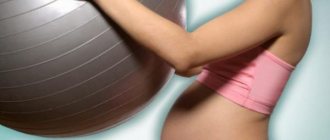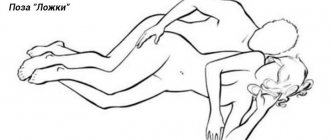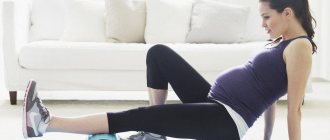Many modern women pay great attention to their body, keeping it in great shape. Even the simplest exercises help improve the condition of the body as a whole and blood circulation, and also strengthen blood vessels. But serious physical activity is undesirable during pregnancy, so Pilates for pregnant women is an excellent replacement for fitness or regular aerobics and represents slow and smooth movements without intense load.
Pilates classes during pregnancy (video lessons)
Every modern woman tries to monitor not only the beauty of her face, but also her body, to keep it in shape and tone. Even the simplest aerobics will help strengthen blood vessels, improve blood circulation and the general condition of the body. But, with the onset of pregnancy, women have to limit themselves in many ways, refusing, among other things, serious physical activity. Pilates for pregnant women is an excellent alternative to regular aerobics or fitness. Can pregnant women do Pilates? What are the advantages and disadvantages of this type of sports activity for this particular condition? Our article will be devoted to this.
Video training about Pilates for pregnant women in the 2nd trimester
If you have never done a type of fitness like Pilates before, and the articles cannot provide you with a complete picture of the whole world of Pilates, you can use video views.
Video training about Pilates for pregnant women in the 2nd trimester
On the Internet today there are simply a lot of videos about Pilates for pregnant women in the 2nd trimester. In these videos you can watch the technique of doing the exercises, learn a lot of useful tips, recommendations, and so on.
Pilates for pregnant women in the 2nd trimester at home
Start practicing today - lead a healthy lifestyle so that your baby is born healthy. Good luck in your endeavors!
The benefits of Pilates for pregnant women
The method of practicing Pitales for pregnant women differs significantly from the usual training regimen.
Such exercises are designed specifically for expectant mothers and are carried out without sudden movements, jumping or increased stress on the body. Pilates for pregnant women is not just a systematic exercise, but also a way to achieve harmony of body and soul.
This type of fitness helps pregnant women keep fit, strengthen and tone weakened pelvic and abdominal muscles, learn proper breathing, self-government, and also receive a lot of positive emotions. Pilates during pregnancy has a beneficial effect on the respiratory system, improves the flexibility of the joints and spine.
Benefits of Pilates during pregnancy:
- Relaxation of the muscles of the spinal region and reduction of pain in this area.
- Gentle and slow exercises help to optimally prepare the pelvic and abdominal muscles for the upcoming birth.
- Blood circulation in the lower extremities improves, which prevents the development of varicose veins.
- Metabolic processes in the intestines are accelerated.
- Correct posture is maintained.
- Group classes have a beneficial effect on the emotional and psychological state of pregnant women. Regular Pilates training prevents the development of depression, nervousness and stress.
- Breathing exercises are one of the most important Pilates techniques, and learning proper breathing before childbirth is very important for pregnant women.
- During pregnancy, women's center of gravity shifts. Pilates classes help normalize coordination.
- In the last three months of pregnancy, exercise promotes the correct positioning of the fetus.
Pilates concept
The set of exercises involves training the pelvic muscles and focusing proper breathing. It is already clear that Pilates classes are beneficial in many ways for pregnant women. But we must not forget about the complexity of the exercises performed, which in some cases are contraindicated.
Gymnastics includes a whole series of principles:
- concentration. That is, the girl trains not only her body, but also her emotional state, which is especially important in the first weeks of pregnancy. After all, it is in the early stages that mothers feel mental discomfort: they are offended, ignored, denied attention, and so on. Exercises will help you manage your consciousness in the early stages, not paying attention to hormonal changes;
- accuracy: quantity, quality and frequency of physical activity, or rather their observance, leads to physical and emotional harmony;
- breath. Working on breathing is the first thing you should pay attention to when playing sports. No matter how much a girl does the exercises, she will not achieve the desired result without breathing control. And this will be useful during labor and childbirth;
- work on muscle groups: abdomen, waist, back and hip. It is these areas of the body that are primarily responsible for bearing a child.
Note! Many pregnant women exercise long before giving birth. You need to start early.
Benefits and indications
Indications for classes: mainly pregnancy and preparation for it. Pregnant women who did these exercises endured pain during labor and childbirth much easier. As they say, a healthy mind in a healthy body!
"Pros" for pregnant women:
- development of the pelvic and abdominal muscles;
- improved blood circulation;
- relieving stress from the spine;
- balance of the center of gravity, that is, concentration allows you to stabilize balance, which is lost in pregnant women;
- normalization of uterine tone;
- orderliness of the nervous system;
- breathing exercises;
- Thanks to gymnastics, the fetus takes on the correct subject.
But, unfortunately, not all mothers are allowed physical activity at all. Please pay attention to this moment!
Contraindications
It is better to refuse exercises if a girl is not feeling well in the early or late stages of pregnancy. To be absolutely sure, you should consult your doctor. The doctor will already answer whether you can or cannot attend the group. Another important information is that classes should be conducted with a professional trainer. You are pregnant after all! You don’t need to trust your health to strangers!
So, the list of contraindications:
- diseases of the joints and spine;
- high body weight of a pregnant woman;
- blood vessel diseases, poor circulation;
- ailments of the respiratory system: asthma, bronchitis, allergies, etc.;
- If before a woman became pregnant, she did not visit sports clubs, then now she certainly shouldn’t.
And here we should emphasize the category of mothers who, to an interesting point, were not supporters of sports. A pregnant woman's body is subjected to significant stress. While doing gymnastics, the girl gets tired. It is more difficult for an unaccustomed body to cope with a growing fetus and exercise. Without physical training, a pregnant woman increases stress. She can enroll in a mothers' school and do breathing exercises, but nothing more.
Pilates involves performing exercises that strengthen specific muscles: the abdominals and pelvic floor. During training, breathing normalizes, lung capacity expands, and flexibility of the musculoskeletal system improves.
Restrictions
In addition to the benefits, modern gymnastics for expectant mothers, like any other type of sports exercise, has some contraindications. Women are not allowed to do Pilates during pregnancy:
- with diseases of the respiratory and cardiovascular systems;
- if there is a threat of miscarriage;
- with a low placenta;
- during a difficult pregnancy, which is accompanied by toxicosis, swelling and excessive weight gain;
- if there are problems with the spine and joints acquired during pregnancy or genetically caused.
Before starting Pilates, the expectant mother simply needs to consult her doctor, especially if she has not previously exercised. An experienced trainer will select an individual load and carefully monitor its increase. As a result of this approach, classes will bring great benefits to the expectant mother.
Features of the classes
The 1st trimester of pregnancy is exactly the period when you can begin to master the exercise technique.
During exercise, a pregnant woman should fully analyze the sensations with every movement. At the same time, there should be no discomfort or pain in the muscles after training. Any discomfort after exercise indicates that the workout should be stopped. All movements using power loads, holding your breath and jumping are completely excluded.
It is strictly forbidden to lie on your stomach during exercise, even in the early stages of pregnancy.
Particular care should be taken when approaching movements that load the abdominal muscle tissue and joints, as well as movements to maintain balance.
Pilates for pregnant women is smooth, slow and moderate movements without intense loads.
The training schedule for each woman is calculated individually. In general, three sessions per week are enough to eliminate the risk of stress on the body and still get the maximum benefit from these excellent physical therapy activities.
Sports and pregnancy
If you doubt the advisability of playing sports during pregnancy, then feel free to discard them. If you were previously active and played sports, then during the first weeks of pregnancy you need to begin to gradually reduce your load. If you haven't played sports before. Then the loads must be gradually increased. Pilates for pregnant women is most suitable during this period of time. This is a set of exercises that will allow you to prepare for childbirth and make it easier.
In Pilates, a special place is occupied by proper breathing, which will allow you to efficiently fill the blood with oxygen and this will have a positive effect on the health of your unborn baby. Also, the ability to breathe correctly will not be superfluous during childbirth.
Pilates for pregnant women will allow you to improve your posture and this will have a positive effect on the development of the fetus. During childbirth, the strength of the pelvic muscles, which are actively worked out during Pilates classes, is of great importance. Also, this system of physical exercises allows you to effectively relieve tension from the spinal column, which will allow you to eliminate pain in the back. Pilates for pregnant women will be very useful after the birth of the baby, as it will allow you to regain your previous figure as soon as possible.
Technique of training by trimesters
For pregnant women who have previously played sports, the method of exercise in the first trimester is slightly different than for expectant mothers who have no sports training at all. A gradual reduction in load is carried out in the second trimester.
For safety, Pilates classes are recommended to be carried out under the supervision of a trainer in the gym, since in the first trimester pregnancy is unstable and the slightest increase in load can provoke a miscarriage.
Exercises for 1st trimester
At the initial stage of training, a woman should monitor her condition and well-being by performing the following exercises:
- Gymnastics to develop proper breathing. Stand on your feet, place your lower limbs shoulder-width apart, lower your arms. Do rhythmic inhalation and exhalation separately - first with the chest, then with the abdominal area. While inhaling, you need to stretch out to your full height.
- Warm-up for the cervical spine. Make alternating head tilts: first to the left, then to the right, forward and backward. After this, you need to make rotating movements of the head without throwing it back. Your shoulders should remain motionless while performing this exercise.
- Extend your arms to the sides in line with your shoulders, taking a deep breath. As you exhale, return to the original position. This is an exercise for the lungs.
- Lean on your knees and palms. As you inhale, raise your left arm and hold it at body level, straighten your left leg, stretching it back. Do the same technique with the right arm and leg.
- Exercise "cat". Take a deep breath, slightly arching your back, as you exhale, round your back, lifting your spine upward, and return to the starting position.
- Sit on a yoga or fitness mat. Spread your lower limbs and arms to your sides, maintaining an even posture. Make smooth turns of the body, first to the left, then to the right.
- For relaxation, the following action is necessary: from resting on your knees and palms, you need to sit on your heels, lowering your body to the bottom. In this case, the muscles of the spinal region should be as relaxed as possible, and the arms should be extended forward. The knees should be separated as much as possible to eliminate the risk of pressure on the abdomen.
Class Rules
- Selection of the optimal complex and alternation of exercises.
- Working out the required muscle group.
- Monitoring the correct execution of movements (with the help of an instructor).
- Adjustment of training time based on personal feelings and physical endurance (from 15 to 40 minutes).
Important!
During squats in recent weeks, it is necessary to spread your legs, avoiding squeezing your growing belly.
If the workout is carried out at the right pace, after it the expectant mother feels lightness and satisfaction. Fatigue and muscle pain are a bad sign and require additional consultation with a gynecologist and Pilates instructor.
After giving birth without complications, you can return to Pilates within a month. By gradually increasing the load, the body will quickly return to its “pre-pregnancy” shape, and the young mother will radiate strength and energy. Performing special Pilates exercises will allow the expectant mother to maximally prepare her body for the upcoming birth and avoid many troubles associated with complications at any stage of pregnancy.
Pregnancy in a woman’s life is both a happy and an anxious period. The realization that a new life is growing in you brings great joy, and the not always pleasant changes occurring in your body are frightening and disturbing. Exercise will help you get through this difficult time and prepare you for childbirth. Pregnancy and sports are quite compatible things. Pilates exercises are an acceptable choice during pregnancy. We'll talk about them.
Sports during pregnancy
To exercise during pregnancy or not to exercise? The answer is clear - study. If before pregnancy you led an active lifestyle, a passion for sports, in the first weeks of pregnancy, you need to continue, gradually reducing the load. If you have been inactive, then the loads need to be increased gradually.
Pilates during pregnancy will help you recover more easily after giving birth. You will quickly return to your previous forms by practicing it after childbirth.
What to avoid
You should start doing Pilates in the 1st trimester of pregnancy. First you need to consult with the doctor who is observing you, this is very important. As you do the exercises, pay attention to how you feel. If you experience discomfort or, God forbid, pain, you must stop immediately.
During pregnancy, you need to avoid exercises that involve lifting weights, jumping, and holding your breath. You cannot do exercises while lying on your stomach; reduce the number of exercises when lying on your back, this is especially important for the second and third trimesters.
It is very difficult for pregnant women to perform balance exercises, since their center of gravity is shifted. You should also avoid exercises that place significant stress on the joints and where abdominal tension is required.
You should exercise, without bringing yourself to the point of extreme fatigue, two to three times a week. Exercises should be performed in a calm, measured rhythm, and monitor your breathing. After completing the main complex, you need to do relaxation exercises. When practicing Pilates, you do not need complex and expensive sports equipment, you only need a yoga mat. Try to repeat all exercises 8-10 times, and monitor your well-being.
It is best if you start doing Pilates for pregnant women under the guidance of an experienced trainer. This will help you most effectively prepare yourself for childbirth and avoid many mistakes.
A set of Pilates exercises during pregnancy
Exercise 1. Get on all fours. Knees hip-width apart, hands shoulder-width apart, arms can be slightly bent. Inhaling, spread your shoulders and move your pelvis, arching your back, rounding it. As you exhale, bend slightly at the chest.
This exercise is good for the lower back and relieves tension in this area. While performing it, try not to strain your abs.
Exercise 2. You need to lie on your side, bend your legs at a right angle. Hands in front of you, with palms folded. As you inhale, raise your hand up and place it behind your back so that your shoulder blade touches the floor. As you exhale, return your hand to its original position. We perform 8-10 times, turn over to the other side and repeat the exercise.
In this case, we stretch the pectoral and intercostal muscles.
Exercise 3. The position is the same as in the first exercise, only we place our knees together. As you inhale, lower your pelvis to the floor, towards your hands; as you exhale, we return to the starting position. Repeat on the other side.
This exercise tones the muscles of the back, pelvis and legs.
Exercise 4. Let's lie on our back. Legs are bent at the knees and spread apart. As you inhale, raise your tailbone so that your body rests only on your shoulders. We linger in this position slightly, then, as we exhale, we lower ourselves to the floor.
This is an exercise for the back muscles and buttocks.
Exercise 5. Position on your side, legs extended and slightly shifted forward relative to the body. The head rests on the hand. As you inhale, lift your upper leg and move it forward. As you exhale, return to the starting position. We perform it several times, turn to the other side and repeat.
This exercise develops the muscles of the hips and pelvis.
Exercise 6. We get down on our knees, spreading them so that the stomach is comfortably positioned. We lower our forehead to the floor, our hands along the body. Let's relax and breathe.
We do this exercise at the end of class or when you need to take a break.
Taking care of a woman’s figure should not end when she becomes pregnant. Without giving your body its due during this special period, you may later, after childbirth, end up with many problems, which will be both difficult and costly to get rid of.
Precautionary measures
Pilates during pregnancy requires following some very important recommendations:
- You can start classes no earlier than an hour after eating;
- all exercises must be performed slowly, smoothly and without sudden movements;
- the exercise with the starting position on the back must be completely excluded from the general training program;
- to eliminate the risk of hypothermia, it is recommended to conduct training on a gymnastic mat or mat;
- eliminate as much stress as possible on the joints during exercise;
- Slow, pleasant music during training promotes a good mood and calmness;
- To eliminate the risk of high stress on the body, it is necessary to perform relaxation activities between exercises.
Kegel exercises during pregnancy
These exercises are designed to properly tense and relax the pelvic muscles, that is, pump them while controlling this process. You need to start by contracting the intimate muscles.
Exercises
All Kegel exercises are aimed at stressing the pelvic muscles with a certain concentration on a particular exercise, only with different variations.
“Elevator” - imagining that the vagina is an elevator, you begin to strain it a little, then, without letting go, you squeeze even harder and the third time even harder (you went up the elevator). Lowering is carried out in the same way. That is, you tense your intimate muscles in 3 stages.
“Waves” - the muscles of the vagina and anus alternately tense and relax. And relaxation is the opposite - first the anus, and then the vagina.
Contraindications
Pain and discomfort during exercise are the first contraindication for any type of physical activity during pregnancy. Regarding Kegel exercises, it is better to consult with your doctor; perhaps not all exercises will be contraindicated for you, and you can choose useful ones.
Benefits of classes
Pilates is a system of exercises that was developed by Joseph Pilates at the beginning of the last century. Initially, the system was intended for people who faced long-term recovery from injuries. The creator himself defined his method as a way to achieve harmony between body, mind and spirit.
Essentially, Pilates is a set of special exercises that are supposed to be performed at a very slow pace. The main goal of the technique is to improve the condition of joints and muscle tissue, eliminate pain, tension in individual muscles, improve posture, normalize blood circulation and improve sleep and appetite.
The big advantage of the technique is that it is suitable for both athletic people who have previously trained and absolute beginners, and the exercises can be practiced in a group in a fitness center or at home with equal effectiveness. The likelihood of injury during Pilates classes is minimized. But there are also some nuances - independent exercise, experts say, is only permissible for those who have at least the third level of training, that is, who practices Pilates at an advanced level.
Obstetricians and gynecologists around the world unanimously recognized Pilates as acceptable and recommended for pregnant women. Naturally, there is a special set of exercises that was created and used exclusively for women “in an interesting position.” The benefits are great, because a woman can not only keep her body, muscles, respiratory organs, and blood vessels in shape, but also receives a charge of good mood.
A psycho-emotional background in a positive way is very important for the expectant mother, because the stress hormones that are produced in an anxious and nervous woman are also received by the child, and they do not benefit him during pregnancy.
Slow exercises aimed at specific muscle groups help prepare the muscles of the abs, back, and pelvis for the upcoming birth. Proper breathing during exercise helps enrich the blood with oxygen, which means that the baby receives more nutrition through the mother-placenta-fetus system.
Joints, especially the lower extremities, during the period of bearing a baby, undergo a load that is tens of times greater than the usual load on them outside of pregnancy. Pilates helps relieve tension, restore normal blood circulation, and ease the burden that nature places on the spine, legs, knees, hips and lower back of a pregnant woman.
Thus, you can and should do Pilates, since this type of fitness helps to achieve the following goals:
- the load on the back and lower back is reduced , the physiological pain characteristic of the second half of pregnancy is reduced;
- the normal tone of the pelvic and abdominal muscles increases , which helps prepare for labor - during the birth process, it is these muscles that will experience the heaviest load;
- blood circulation improves , which helps prevent thrombosis, varicose veins, hemorrhoids;
- intestinal motility improves , which helps normalize digestion and metabolism.
A woman who practices Pilates gradually learns to maintain beautiful and correct posture, which is certainly beneficial for the spine. The powerful charge of good mood that a woman receives during training leaves no chance of depression and hypochondria, which often develop in expectant mothers due to hormonal changes if women prefer to lie on the couch throughout their pregnancy.
It is believed that Pilates helps turn the baby into the correct position in the third trimester if he is in a transverse or breech presentation. This statement is controversial, since a direct relationship has not been proven. But the reviews from expectant mothers are positive, and this effect is repeatedly described by them.
Pilates: what is it?
A popular technique was invented by a doctor originally from Germany, Joseph Pilates. The system of gymnastic exercises was actively used for the rehabilitation of wounded soldiers in the First World War. Later, those who dreamed of losing weight paid attention to the technique. Having assessed the benefits of the classes, doctors began to recommend them to expectant mothers.
Pilates is a simple exercise combined with breathing exercises. The main principles of the methodology:
- Relaxation. You need to study “lightly”. Areas that do not work during the exercise should be as relaxed as possible.
- Concentration. It is important to concentrate on doing the exercise and discard unnecessary thoughts. This allows you to carefully work out the areas and avoid injury.
- Smoothness. Only smooth movements are encouraged, no jerks. The workout should take place at an average pace. There is no need to apply excessive force when charging.
- Breath. It is important to learn proper chest breathing: as you inhale, a lot of oxygen enters the lungs, the back opens, as it exits, the lungs are emptied, and the ribs return to their previous position. You cannot breathe with your stomach and strain your abs.
Basic Rules
As in any other sport or fitness, Pilates adherents have their own rules. These are rather safety rules, compliance with which will help reduce risks and increase efficiency. Therefore, you need to start with their careful study.
- The system does not set an acceptable deadline for starting classes - you can start studying at any time. But it is best to do this, if not when planning a pregnancy, then at least from the first trimester.
- Correctly performed exercises and the effectiveness of the training are indicated by the complete absence of pain in the muscles after training. If it hurts, contact the instructor and together figure out what was done wrong; you may have to reconsider the list of exercises and the load.
- When performing any technique, it is important for a woman to be able to focus on her actions and sensations. It is very important to learn to analyze your feelings during activity. Gradually, the body itself will begin to “tell” how and what needs to be done in order for the benefits to be maximum.
- Pilates completely eliminates power loads, sudden and fast movements, holding your breath, jumping, and abdominal exercises.
- In the later stages, and preferably from the second half of pregnancy, you should exclude exercises that involve training the ability to maintain balance - with a shifted center of gravity, this can lead to a fall.
- The schedule and frequency of classes should be assigned individually, but on average, it is enough for an expectant mother to attend training 2-3 times a week.
It is advisable not to eat before training; eating an hour and a half before the start of training is considered optimal.
Pilates is distinguished from other types of fitness by a clear sequence of principles. Without observing even one of them, you can’t count on a positive result. The principles were formulated by Joseph Pilates himself and are strictly observed:
- concentration - a woman needs to monitor her bodily sensations during the exercise;
- centering - special concentration of attention on the muscles while working out a certain group;
- control and self-control - exercises must be performed technically correctly, and not as it turns out;
- breathing - it should be controlled and even;
- smoothness - all movements should be slow and very careful.
Classes for pregnant women in the pool
Why are they useful?
There are 3 categories of exercises in the pool that have helped in different ways during labor and throughout pregnancy:
- Swimming: gives good physical exercise, relieves stress on the spine, strengthens the chest muscles. Swimming promotes good lactation after childbirth, as it improves blood circulation in the chest;
- Diving: a good way to prepare your baby for the lack of oxygen and nutrition during contractions. Diving prevents fetal hypoxia. They say that children whose mother dived during pregnancy move faster through the birth canal to the exit and adapt much faster than other children;
- water aerobics during pregnancy does not aim to lose extra pounds. Her goal at this stage is to keep the muscles in proper condition so that they become a good helper during childbirth and quickly return to normal after it.
Exercises
Standing at the side, you can swing your leg at the surface of the water. Raise your leg in front of you and then pull and then move your toe. Circular movements of the leg in the hip joint will help strengthen the thigh muscles.
Hanging on the side - facing the side, you can perform the following exercises for pregnant women: hang on the side and bend your knees, while your feet rest against the wall as wide as possible. We do lunges to the sides alternately. With your back to the side you can:
- rotate bent legs left and right;
- imitate the movement of your legs as if you were swimming breaststroke;
- Straighten your legs in front of you, spread and bring them together on the surface of the water, and then, crossing them, try to lift them slightly above the water.
Breathing in the pool
- Inhale noisily over the water and exhale into the water.
- A quick inhale over the water and a long exhale into the water.
- Concentrate on inhalation and exhalation for 10 seconds.
- You can also practice “dog” shallow breathing in the pool, which was described above.
Contraindications
Habitual miscarriages, severe toxicosis, uterine bleeding, systematic pain in the lower abdomen after exercise, acute tuberculosis, infectious diseases and other diseases in the acute period.
A set of exercises by trimester
Much depends on what trimester you are in, since the Pilates method involves a differentiated approach to stress at different stages of gestation. And it is obvious that trained women will receive different loads than those who have never been to the gym before.
1st trimester
Does not require significant load restrictions. This usually occurs from mid-pregnancy. At the beginning of pregnancy, independent studies, if you have not had such experience before, are extremely undesirable. At best, you will do the exercises with errors, at worst, you can harm yourself. It is better to study in a group under the supervision of an instructor.
Several exercises are usually recommended early in pregnancy.
- Breathing technique training . Standing on the floor with her feet shoulder-width apart, the woman straightens her back and lowers her arms. Inhale alternately through the chest and stomach. When you inhale, you need to stretch up, and when you come out, you need to lower.
- Neck . Alternate slow tilts of the head to the right, left, forward and backward. This exercise is included in any gymnastics, but in our case you need to do nods and bends slowly.
- Lungs . Respiratory training will be an exercise that combines movement with breathing. The arms are spread in different directions so that they are in line with the shoulders. At the same time, take a leisurely deep breath and, lowering your hands, exhale.
- Arms, back, abs . The starting position is on all fours, resting on your knees and palms. One arm is raised simultaneously with inhalation, and the left leg is extended and pulled back. Then, again from the starting position, do the same with the other hand and foot.
One of the most famous exercises and loved by women is the “Cat” - an exercise in which, in the same position, you bend your back while inhaling and round it, similar to the back of a cat, as you exhale.
Exercises for pregnant women: 1st trimester
The first 14 weeks are the formation of the main organs of the future baby. The first trimester is considered the most dangerous for the development of the embryo, therefore the loads at this time should be treated extremely carefully. Extensive physical activity is contraindicated throughout pregnancy, but in the first trimester special emphasis is placed on this so as not to interfere with the attachment of the fertilized egg to the walls of the uterus.
You can't put pressure on your abs, as this can lead to miscarriage. You can strengthen your hips and start breathing exercises for pregnant women. The characteristics of exercises for the first trimester are effectiveness and simplicity.
Examples of exercises
Strengthening the breast muscles is the only way to preserve its beauty after childbirth. You can help this in the following way: bring your hands together at chest level and for a minute try to squeeze your palms together as tightly as possible.
Circular movements performed by this part of the body when your feet are shoulder-width apart will help improve blood circulation in the pelvic area.
Recommendations for classes
Pilates can be practiced not only by mothers who attended these classes before pregnancy, but also by new ones. An important point: not all Pilates exercises can be performed, but only those specialized for pregnant women, regardless of trimester. There are exercises in Pilates that can be harmful to pregnant women. It is necessary to exclude the following fitness loads:
- exercise lying on your stomach;
- exercise in which the abs are tense;
- exercises with holding your breath;
- balance and coordination exercises;
- elements with a load on the joints.
It is better for pregnant women to go to individual Pilates training with a personal trainer. It is not recommended to train in general groups; the trainer will not be able to monitor everyone at the same time. During classes, you should definitely take into account the duration of pregnancy, the level of physical endurance, whether the mother was involved in fitness before pregnancy, how she feels when performing movements. You need to exercise at an individual rhythm, listening to your condition. This is the only way to achieve the best results for the mother and absolute safety for the baby.
When starting classes, you should do them regularly - two to three times a week. Only mothers who exercised every day before getting pregnant can exercise more than three times, and only if they feel great during and after the lesson. If you train less than twice a week, then it’s better not to train at all , because... Irregular fitness training is a huge stress for the body.
Pregnant women should not practice Pilates at home using books or videos. Mastering Pilates for pregnant women at home on your own is dangerous. This is an absolutely unnecessary experiment, because... Only an experienced instructor can know the correct technique. Even if you follow the clear recommendations from the video, choosing Pilates at home, you will not be able to see yourself from the outside and correct mistakes in time. Lessons are held to relaxing music, using accessories - fitball and other fitness equipment that are not at home.
Benefits of Pilates during pregnancy
That part of the people who promote Pilates during pregnancy is undoubtedly right. The advantages of this type of gymnastics are obvious:
- the work of the abdominal and pelvic muscles improves, since relaxed muscles can complicate the process of childbirth;
- exercises relieve heaviness from the back;
- the likelihood of varicose veins forming in expectant mothers is reduced due to improved blood circulation, and the risk of edema will also be reduced;
- a sense of concentration develops;
- prevention of psychosis and stress;
- there is more space and freedom for the baby, who can feel comfortable in the womb;
- Pilates during pregnancy will help you get your baby in the right position before giving birth.
If a woman is helped by a good trainer during training, then the quality of the exercises will be at the highest level, and the expectant mother will not feel discomfort. It is recommended to do Pilates three times a week so as not to tire yourself. However, despite the fact that Pilates during pregnancy has many advantages, there are also contraindications.
Lesson plan
A lesson lasts on average from 15 to 45 minutes. It always starts with a warm-up, which includes breathing elements. Passes while sitting on an inflatable ball or on a mat in a butterfly pose. The main part of the training is carried out in the following starting positions:
- On the side they perform leg swings, leg movements in a circle, scissors exercise, imitation of a bicycle. All exercises are done smoothly, with a small range of motion.
- On all fours they perform - lifting opposite arms and legs, alternate lifting of arms and legs, lifting a leg bent at the knee. The main thing in this position is not to arch your lower back.
- On the back they perform complex combined exercises, circular movements of the pelvis or legs.
- While sitting on a fitball, perform elements for the muscles of the neck and arms.
Finally, perform relaxing movements and breathing exercises. The lesson includes special breaks for rest. One of the most interesting is the position of the baby in the womb (kneel, spread your legs wide, sit on your heels, lie with your body forward).
Exercises for pregnant women: 2nd trimester
The 2nd trimester is a time to relax a little and pay attention to more strenuous physical activity. But this does not mean that you can carry heavy bags from the store and gallop in the morning. Most of the exercises during this period are aimed at the pelvic area. They help avoid such an unpleasant problem as urinary incontinence. Exercises that require performing a load on one leg are excluded from classes.
It is recommended to use a bandage during exercise, since the size of the uterus is already significant and the load on the spine increases. Also, exercises on the back are removed to the maximum, they are replaced with exercises in the position on the side. Don't forget that any activity begins with a warm-up, which prepares the muscles for further work.
Examples of exercises
One of the most effective exercises for pregnant women is performed in the little mermaid pose with arms extended upward, which alternately lower behind the head. The breasts are strengthened in the same way as in the 1st trimester. A pose that helps you relax is when your buttocks are on your heels, stretching forward you need to touch your forehead to the floor, in this case your stomach drops to the floor between your knees.









